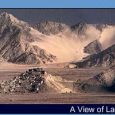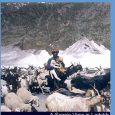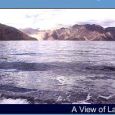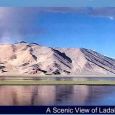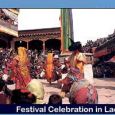Ladakh
Advertisement
INTERNAL TRANSPORT
The best and most reasonable way to travel within the region way to travel within the region is by public buses, which ply on fixed routes according to fixed time schedules. The most comfortable and convenient through expensive mode of travel, however, is by taxis, cars, and Gypsy, which are available for hire on fixed point-to-Point tariff.
For visits to the newly opened areas of Nubra, Changthang and Dah-Hanu it is mandatory to engage the services of a registered/recognized travel agency for making all the requisite arrangements including internal transport. Detailed information about bus schedules, taxi tariff, travel agencies, etc. can be obtained from the Tourist Office.
By Road
The main overland approach to Ladakh is from the Kashmir Valley via the 434-km Srinagar-Leh road, which remains open for traffic from early June to November. The most dramatic part of this road journey is the ascent up the 11,500 feet /3,505 m high Zoji-la, the passing the Great Himalayan Wall that serves as the gateway to Ladakh.
The J&K State Road Transport Corporation (J&KSRTC) operates regular Deluxe and Ordinary bus services between Srinagar and Leh on this route with an overnight halt at Kargil. Taxis, cars and jeeps are also available at Srinagar for the journey. Groups can charter deluxe and A-class buses for Leh, Kargil or Padum (Zanskar) from the J and K SRTC at Srinagar.
Since 1989, the 473-km Manali-Leh road has been serving as the second land approach to Ladakh. Open for the traffic from around mid-June to early October, this high road traverses the upland desert plateaux of Rupshu whose altitude ranges from 3,660m to 4,570m.
A number of high passes fall en route among which the highest one, known as Taglang-la, is the world's second highest motor able pass at an altitude of 17,469 feet/5,325m. H.P. Tourism, H.P. SRTC and J&K SRTC operate Deluxe and Ordinary bus services between Manali and LEH. The bus journey between Leh and Manali takes about 19 hours or two days with an overnight halt in camps at Serchu or Pang. Gypsy and jeep taxis are also available, both at Manali and Leh.
By Air
The quickest way out of Ladakh region is by plane. Airline service operates regular scheduled flights to Leh from Delhi, Chandigarh, Jammu and Srinagar. Some private airlines are also planning to operate air services betwe4n Delhi and Leh in the near future.
Zanskar : About 20-km south of Rangdum stands the Pazila watershed across which lies Zanskar, the most isolated of all the trans Himalayan Valleys. The Panzela Top (4,401 m) is the picturesque tableland adorned with two small alpine lakes and surrounded by snow-covered peaks.
Hemis : Thanks to the Hemis Setchu festival - one of the few held in summer, when the passes are open - Hemis, 45-km southeast of Leh, is the most famous Gompa in Ladakh.
Sankar Gompa, 3-km north of the town centre, is among the most accessible monasteries in central Ladakh - hence its restricted visiting hours for tourists
Alchi : Driving past on the nearby Srinagar-Leh highway, you'd never guess that this is one of the most significant historical sites in Asia.
Baltoro Glacier : is situated on the southern slopes of the central Karakoram Range in the Baltistan area of Jammu and Kashmir. The location of Boltoro is in a huge arena hemmed by high peaks.
Baralacha Pass :On the long Manali -Leh road and providing a route across the Baralacha range is the famous Baralacha Pass. It is situated at a spectacular 16,400 ft above sea level. The pass itself is 8-km long, and is literally the pass "where many roads meet".
Biafo Glacier : is located on the south-facing slopes of the Karakoram Range in the Baltistan area of Ladakh. It has a length of about 60-km and descends from a large glacial trough.
Dah-Hanu : are places on the far side of the great Indus River on the far side of Leh. Surrounded by the great Hindu - Kush mountains and peopled by a hardy but gentle people who have a bank of strange legends to relate for the weary traveller's ears.
Dosmoche: An ancient tradition started by the kings of Ladakh, Docmoche is still celebrated every year in February with great pomp and fervour. The courtyard of the chapel below the gates of the Leh of the Leh Palace comes alive with the music of drums and the thumping steps of the masked Lamas from different monasteries performing the sacred dance-drama.
Hemis Festival: One of the most popular monastic selections in Ladakh, the festival of them is symbolises the centuries-old traditions of the Kar-gyur-pa sect of Tibetan Buddhism.
Hemis High Altitude Wildlife Sanctuary: The Hemis High Altitude National Park includes the catchments of two valleys, which drain into the River Indus. It is named after the famous monastery -- Hemis, and sprawls over 600-sq-km in the Markha And Rumbak valleys.
Karakoram Pass : lies on one of the highest trade routes in the world for Yarkand in Central Asia.
Khardong La & Digar La Pass: is situated at an incredible elevation of over 5,800 m (18,680 ft). It lies on the route between Leh and the Shyok and Nubra valley
The Tso Morari Lake is one of the largest lakes in Ladakh region and is almost like an inland sea. At an altitude of almost 4,500 meters, the Pangong Tso is only 8-km wide at its broadest but is an amazing 134-km long. Kyaghr lake is the halting place for trekkers moving from the Kiangdum camping ground to the Tsomorari Lake.
Lamayuru : If one sight could be said to sum up Ladakh, it would have to be Lamayuru Gompa, 130-km west of Leh. Hemmed in by a moonscape of scree covered mountains, the white washed medieval monastery towers above a scruffy cluster of tumbledown mud brick houses from the top of a near vertical, weirdly eroded cliff.
Likkir : 6-km to the north of the main Leh-Srinagar highway, shortly before the village of Saspol, the large and wealthy Gompa of Likkir, home to around one hundred monks, is renowned for its huge yellow statue of the Buddha to come which towers above the terraced fields and village below.
Losar : is the most elaborate of all the socio -religious events of Ladakh. It involves the entire population of the region. Interestingly, the rites and rituals are a mixture of Buddhist and the pre Buddhist Bon religious practices.
Matho, 27-km south of Leh, straddles a spur at the mouth of an idyllic side valley. Though no less interesting or scenically situated than its neighbours, the Gompa sees comparatively few visitors.
Matho Nagrang : On the 15th day of the 1st Tibetan month, a 2-day festival is held at the Matho Monastery - the only Saskyapa monastic establishment in Ladakh.
Monastic Festivals : The monastic festivals are the events that provide the average Ladakhi with the spice of life. No other festival can match them in religious and entertainment value. These festivals are held to commemorate the founding of a monastery, the birthday of its patron saint or major events in the evolution of Tibetan Buddhism.
Mulbekh : West of Lamayuru, the main road crawls to the top of Fatu-la (4,091m), the highest pass between Leh and Srinagar, and then ascends Namika-la ("Sky Pillar"), so called because of the jagged pinnacle of rock that looms above it to the south.
Namgyal Tsemo Gompa : Once one is acclimatized to the altitude, the stiff early morning hike up to Namgyal Tsemo Gompa, the monastery perched precariously on the shaly crag behind Leh palace, is a great way to start the day.
Nubra Glacier: The Nubra glacier is located on the southern slopes of the Karakoram Range in the Ladakh region of Jammu and Kashmir. It is a large glacier located in a huge amphitheater that is ringed by towering peaks.
Padum: Once the capital of the ancient kingdom of Zanskar, Padum (3,505 m) is the present day administrative headquarters of the region. With a population of nearly 1,500, Padum can be described as the most populous settlement of Zanskar, otherwise a very scarcely inhabited valley.
Panamic: After a cleansing trip to the hot springs, where two rooms each have a deep tub filled with piping hot sulphurous water, where's little to do in Panamic other than walk. A dot on the mountainside across the river, Ensa Gompa makes an obvious excursion.
Pangong Tso: Pangong Tso, 154-km to the southeast of Leh, is one of the largest salt-water lakes in Asia, a long narrow strip of water stretching from Ladakh east into Tibet. Only a quarter of the 130-km-long lake is in Ladakh, and the Indian army, who experienced bitter losses along its shores in the war against China in 1962, guard their side of the frontier.
Phyang : A mere 24-km west of Leh, Phyang Gompa looms large at the head of a secluded side valley that tapers north into the rugged Ladakh range from the Srinagar highway.
Phyang Tsedup : Phyang is one of the two Dringungpa Monasteries in Ladakh. This monastery 17-km west of Leh, holds its festival in July/august. Like other monastic festivals, sacred dance-dramas or 'chhams' form the core of this festival.
River Rafting : While water levels are high, between the end of June and late August, Leh's more entrepreneurial travel agents operate rafting trips on the river Indus.
Sankoo :A picturesque expanse surrounded by colorful rocky mountains, Sankoo is an upcoming township with a small bazaar and numerous villages around. Dense plantations of Poplers, Willows, Myricarea and wild Roses fill the bowl shaped valley, giving it the ambience of a man-made forest tucked within the mountain ramparts.
Siachen Glacier :lies in the extreme north-central part of Jammu and Kashmir near the border of India and Tibet. With a length of about 72-km, Siachen is known as the largest glacier in the world outside the Polar Regions.
Sind Valley : Considered by many to be the most beautiful of Kashmir's side valleys, the Sind is also the access route to the Zoji la pass.
Sindhu Darshan Festival : The Sindhu Darshan or Sindhu Festival aims at projecting the Indus as a symbol of India's unity and communal harmony. Whilst promoting tourism to this area, this festival is also a symbolic salute to the brave soldier of India.
Siser La : Siser La is a high mountain pass in northern Ladakh in the state of Jammu and Kashmir. It lies on one of the highest trade routes in the world for Yarkand in Central Asia.
Stok: Just beyond the Tibetan refugee camp at Choglamsar, a side road turns left off the highway to cross the Indus on an iron bridge plastered with prayer flags, and then continues up towards a huge TV mast.
Stongdey/ Stongde Monastery: The monastery of Stongdey lies 18-km to the north of Padum, on the road leading to Zangla. An old foundation associated with the Tibetan Yogi, Marpa, Stongdey is now the second largest monastic establishment of Zanskar
Sumur: Soon after passing Khalsar, the road crosses the confluence of the Shyok and Nubra to a patch of green sloping from the river to the base of precipitous mountains. Sumur is home to the Nubbra valley's most important monastery.
Suru Valley: The Suru Valley is formed by the catchment are of the SuruRiver, which rises from the Panzella glacier.
The Nubra Valley: The 18,640 feet high Khardung La pass forms the divide between the Nubra Valley and Leh. After crossing the Khardung La, one descends to a place called "Khalsar", situated on the left bank of the Shyok River.
Tulimpati La: The Tulimpati La is located in Ladakh region of Jammu and Kahsmir. This pass opens up the route from the Nubra Valley of Ladakh towards the Karakoram Pass.
Zozi La: is a famous pass over the main Himalayan range on the Srinagar-Leh highway. As a matter of fact, this pass has often been termed as the gateway to Ladakh.
Buddhism In Ladakh: Although the Islamic influence extends out of the Kashmir valley as far as Kargil in Ladakh, the predominant religion is overwhelmingly the Tibetan, Lamaist form of Buddhism.
Chemrey: Clinging like a swallow's nest to the sides of a shaly conical hill, the magnificent Gompa of Chemrey sees very few visitors because of its location - tucked up the side valley that runs from Karu, below Hemis, to the Chang-la pass into Pangong.
Chong Kumdan Glacier: is situated on the lower slopes of the Karakoram Range. It is located in a trough that is surrounded by high peaks on all sides. The melt-water from this glacier flows into the Shyok River, which in turn joins the Indus River. The Chong Kumdan glacier had blocked the flow of the Shyok River several times in the past. Thus the Gapshan Lake was formed which drained away once the ice dam gave way. This glacier can be approached via Skardu in Ladakh.
Ladakhi Dances are very colorful and majestic. The slow and gentle movements of these dances are very well complemented by the richness of jewelled 'Peraks', Silver ornaments and rich music.
Diskit And Hundur : The caramel brown hillside above the old town supports Diskit's picturesque Gompa, built in 1420 by Changzem Tserab Zangpo, a disciple of Tsong-kha-pa.
Gasherbrum Glacier: is located on the southern slopes of the Karakoram Range in the Baltistan area of Ladakh. It lies at the base of the Gasherbrum peak and has a length of about 26-km. The melt-water from this glacier joins the Shyok river system. Glaciers in hanging valleys open into the main glacier. No vegetation grows in this tract due to the extreme conditions of cold. This glacier can be approached via Skardu in Ladakh.
Gu-Stor : literally means 'Sacrifice of the 29th day'. It is traditional to the monasteries of the reformist Geluk-pa order of Tibetan Buddhism. This two-day long festival is held mainly in the Spituk, Thiksay (also spelt as Thiksey) and Karsha (Zanskar) monasteries, at different times every years.
Hispur Glacier : Situated on the southern slopes of the Karakoram Range in the Baltistan area of Ladakh is Hispar Glacier.
Rakaposhi glacier is located on the lower slopes of the Karakoram Range in the Gilgit area of Ladakh. It is tenanted on the north-facing slopes of the Rakaposhi massif. The Rakaposhi glacier feeds an eastern tributary of the Hunza River, which in turn flows into the Indus River. The Rakaposhi glacier lies in a trough whose bottom gently slopes towards the north and northwest. Boulders and rocks are strewn all over the surface. This glacier can be approached via Gilgit in the Ladakh region of Jammu and Kashmir.
Rupshu: Located east of Zanskar, the restricted area of Rupshu is Ladakh's easternmost and most elevated region, blending into western Tibet's high plains. In fact, topographically, but not politically, Rupshu is an integral part of the Chang Tang, Tibet's 600-mile-wide, 15,000-foot high northern steppes, of which it is the westernmost extremity.
The Saltoro glacier is located on the southern slopes of the Karakoram Range in Ladakh. Situated in a cirque of the Saltoro massif, this glacier feeds one of the two main streams of the Saltoro River, which in turn drains into the Shyok River.
Shyok Valley & Indus Valley : Indus is a large valley formed by the main channel of the Indus River as it flows across Ladakh. The Shyok Valley is the valley of the Shyok River -- the river of death. This is a "Yarkandi" (Central Asian) name, probably given by the Central Asian traders.
Thak Thok Gompa : Clustered around a lumpy outcrop of eroded rocks, 4-km up the valley from Chemrey, the small Gompa of Thak Thok (pronounced Tak Tak and meaning "top of the rocks") is the sole representative in Ladakh of the ancient Nyingmapa order.
Zangla: Lying deep in the northern arm of Zanskar at the end of the 35-km long rough road from Padum, Zangla was being ruled by a titular king till his death in 1989. The old castle now in ruins except from a small chapel, occupies a hill, overlooking the desertic valley below.
Zongkhul : A spectacular cave monastery of Zanskar, Zongkhul falls on the Padum-Kishtwar trekking trail, just before the ascent of Omasi-la Pass begins.
June - September


